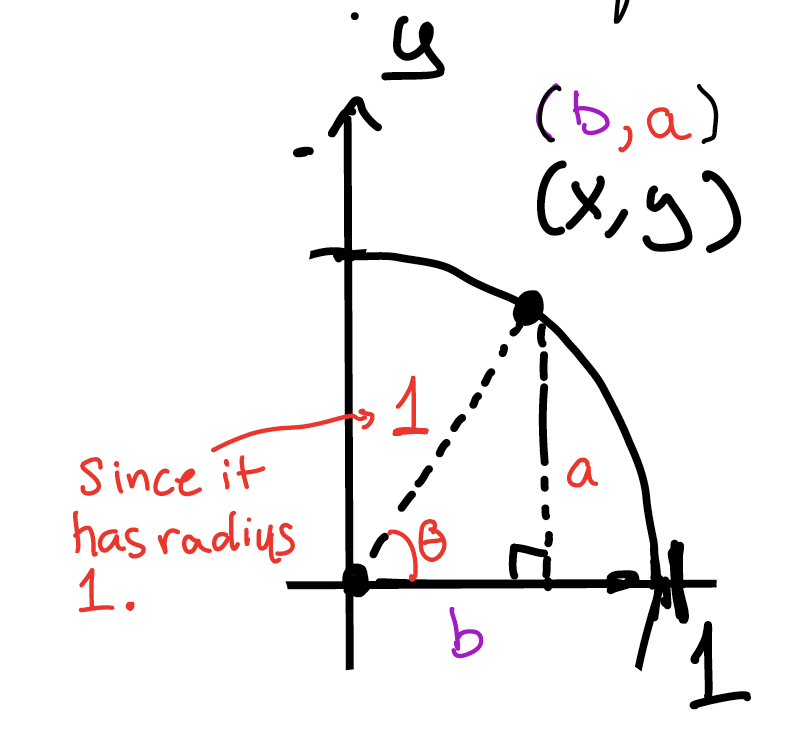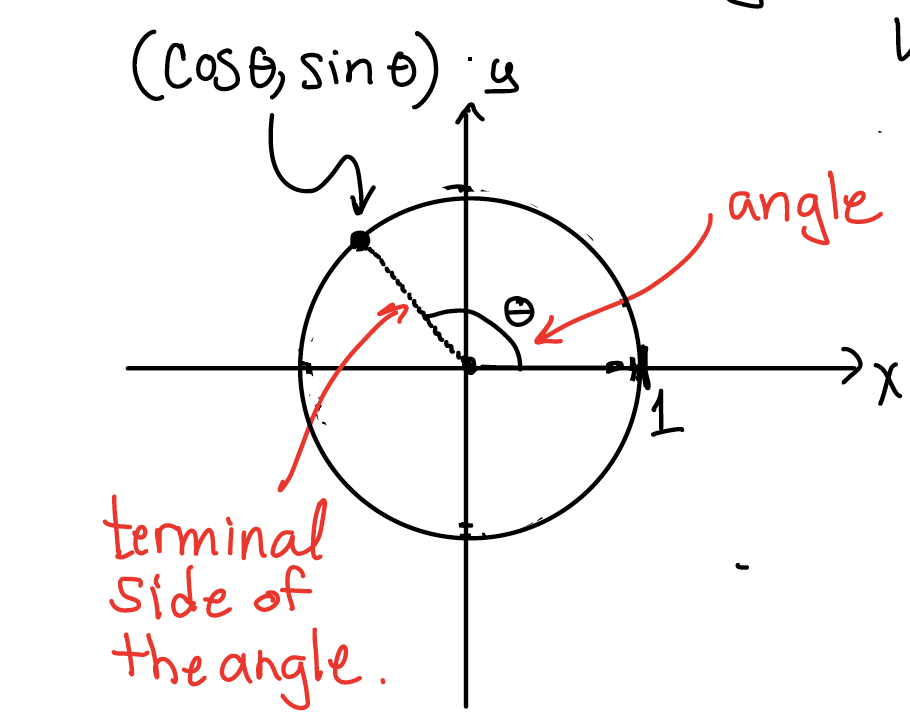Hi Everyone!
On this page you will find some material about Lesson 28. Read through the material below, watch the videos, and follow up with your instructor if you have questions.
Lesson 28: Unit Circles
Table of Contents
Resources
In this section you will find some important information about the specific resources related to this lesson:
- the learning outcomes,
- the section in the textbook,
- the WeBWorK homework sets,
- a link to the pdf of the lesson notes,
- a link to a video lesson.
Learning Outcomes. (from Coburn and Herdlick’s Trigonometry book)
- Use special triangles to find points on a unit circle and locate other points using symmetry.
- Define the six trig functions in terms of a point on the unit circle.
Topic. This lesson covers
Section 3.3: The Unit Circle.
WeBWorK. There is one WeBWorK assignment on today’s material:
UnitCircle
Lesson Notes.
Video Lesson.
Video Lesson 28 (based on Lesson 28 Notes)
Warmup Questions
These are questions on fundamental concepts that you need to know before you can embark on this lesson. Don’t skip them! Take your time to do them, and check your answer by clicking on the “Show Answer” tab.
Warmup Question 1
A unit circle is a circle with radius 1. Find the equation of a unit circle with center at $(0,0)$.
Show Answer 1
$x^2+y^2 =1$
Warmup Question 2
Find four points that belong to the unit circle with center at $(0,0)$.
Show Answer 2
$(0,1), (1,0),(0,-1),(-1,0)$
Warmup Question 3
Check that the following points belong to the circle with center at $(0,0)$ and radius 10.
$$(1,3),(-1,3),(1,-3),(-1,-3)$$
Graph the circle and plot these four points. What do you observe?
Show Answer 3
$1^2+3^2=10$
$(-1)^2+3^2=10$
$1^2+(-3)^2=10$
$(-1)^2+(-3)^2=10$

These four points in symmetric positions with respect to the $x$-axis, $y$-axis and the origin.
Warmup Question 4
State the quadrant of the terminal side of $\theta$ given that $\tan \theta<0$ and $\sec \theta>0$.
Show Answer 4
If $\tan \theta <0$, then the terminal side of $\theta$ must lie in QII or QIV. Since $\sec\theta = \dfrac{1}{\cos\theta}$,
if $\sec\theta>0$ then $\cos\theta>0$ and so the terminal side of $\theta$ must lie in QI or QIV. Hence, if $\tan \theta<0$ and $\sec \theta>0$, we conclude that the terminal side of $\theta$ must lie in QIV.
Review
If you are not comfortable with the Warmup Questions, don’t give up! Click on the indicated lesson for a quick catchup. A brief review will help you boost your confidence to start the new lesson, and that’s perfectly fine.
Need a review? Check
Quick Intro
This is like a mini-lesson with an overview of the main objects of study. It will often contain a list of key words, definitions and properties – all that is new in this lesson. We will use this opportunity to make connections with other concepts. It can be also used as a review of the lesson.
A Quick Intro to Unit Circles
Key Words. Unit circle, reference triangle, reference angle, coterminal angle, trigonometric ratio
$\bigstar$ A unit circle is a circle with center at $(0,0)$ and radius 1. Given $P(x,y)$ on the circle, we have
$$x^2+y^2=1.$$

$\bigstar$ The right triangle on the graph is the reference triangle for the angle $\theta$. It has hypotenuse 1 and legs $x=a$ and $y=b$. So
$$\cos\theta = x,\quad \sin\theta =y, and \tan\theta=\dfrac{y}{x}.$$
Note that the cosine and sine values are the $x$- and $y$-coordinates of the point $P(x,y)$ on the terminal side of $\theta$ that belongs to the unit circle.
In general, we have

$\bigstar$ The reference angle is a positive acute angle between the $x$-axis and the terminal side. In the above picture, the reference angle is $180^\circ -\theta $ or $\pi-\theta$.
$\bigstar$ Angles with the same reference angle have the same trig values except for their sign.
$\bigstar$ Coterminal angles have the same trigonometric values.
Video Lesson
Many times the mini-lesson will not be enough for you to start working on the problems. You need to see someone explaining the material to you. In the video you will find a variety of examples, solved step-by-step – starting from a simple one to a more complex one. Feel free to play them as many times as you need. Pause, rewind, replay, stop… follow your pace!
Video Lesson
A description of the video
In the video you will see how to solve
- $\cos 120^\circ$, $\sin 120^\circ$
- $\sin(-270^\circ)$, $\sin 90^\circ$
- $\cos\left(-\dfrac{11\pi}{4}\right)$, $\sin\left(-\dfrac{11\pi}{4}\right)$, $\tan\left(-\dfrac{11\pi}{4}\right)$
Try Questions
Now that you have read the material and watched the video, it is your turn to put in practice what you have learned. We encourage you to try the Try Questions on your own. When you are done, click on the “Show answer” tab to see if you got the correct answer.
Try Question 1
What is the reference angle for $210^{\circ}$?
Show Answer 1
$30^{\circ}$
Try Question 2
What is the reference angle for $\dfrac{5\pi}{3}$?
Show Answer 2
$\dfrac{\pi}{3}$
Try Question 3
Without using a calculator, explain
(a) how one can find $\sin {\dfrac{\pi}{2}}$.
(b) why $\tan\dfrac{\pi}{2}$ is undefined.
Show Answer 3
Let’s consider $(0,1)$ as the associated point to the angle $\dfrac{\pi}{2}$. So $x=0$ and $y=1$. Furthermore,
$r =\sqrt{x^2+y^2} = \sqrt{0^2+1^2} = \sqrt{1} = 1$.
(a) $\sin {\dfrac{\pi}{2}} = \dfrac{y}{r} =\dfrac{1}{1} = 1$
(b) $\tan\dfrac{\pi}{2} = \dfrac{y}{x} = \dfrac{1}{0}$ which is undefined.
WeBWorK
You should now be ready to start working on the WeBWorK problems. Doing the homework is an essential part of learning. It will help you practice the lesson and reinforce your knowledge.
WeBWork
It is time to do the homework on WeBWork:
UnitCircle
When you are done, come back to this page for the Exit Questions.
Exit Questions
After doing the WeBWorK problems, come back to this page. The Exit Questions include vocabulary checking and conceptual questions. Knowing the vocabulary accurately is important for us to communicate. You will also find one last problem. All these questions will give you an idea as to whether or not you have mastered the material. Remember: the “Show Answer” tab is there for you to check your work!
Exit Questions
- How are the trig ratios related to points on the unit circle?
- If we have a point on the unit circle that is in the second quadrant, and we move counterclockwise a little bit, does the $x$-coordinate of our point decrease or increase? What about the $y$-coordinate?
$\bigstar$ Without using a calculator, find the six trigonometric values of $\dfrac{5\pi}{3}$ in exact form.
Show Answer
The terminal side of $\dfrac{5\pi}{3}$ or $300^{\circ}$ is in QIV. In QIV the only trig values that are positve are cosine and secant.
By Try Question 2, the reference angle is $\dfrac{\pi}{3}$ or $60^{\circ}$. This is one of the angles of the 30-60-90 special triangle. So we know its trig values.
$$\sin\left(\dfrac{\pi}{3} \right)= – \sin\left( \dfrac{\pi}{3}\right) = -\dfrac{\sqrt 3}{2}$$
$$\cos\left(\dfrac{\pi}{3}\right) = \cos\left(\dfrac{\pi}{3}\right) = \dfrac{1}{2}$$
$$\tan\left(\dfrac{\pi}{3} \right)= -\tan\left(\dfrac{\pi}{3} \right)= -\sqrt 3$$
$$\csc\left(\dfrac{\pi}{3} \right)= \dfrac{1}{\sin\left(\dfrac{\pi}{3}\right)}=-\dfrac{2}{\sqrt 3}=-\dfrac{2\sqrt 3}{3}$$
$$\sec\left(\dfrac{\pi}{3}\right)=\dfrac{1}{\cos\left(\dfrac{\pi}{3}\right)}=2$$
$$\cot\left(\dfrac{\pi}{3}\right)=\dfrac{1}{\tan\left(\dfrac{\pi}{3}\right)}=-\dfrac{1}{\sqrt 3}=-\dfrac{\sqrt 3}{3}$$
Need more help?
Don’t wait too long to do the following.
- Watch the additional video resources.
- Talk to your instructor.
- Form a study group.
- Visit a tutor. For more information, check the tutoring page.


